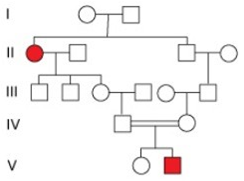What does the pattern of inheritance in this pedigree indicate about the disease allele?

A) The disease allele is recessive.
B) The disease allele is dominant.
C) There is no indication that the disease allele is either dominant or recessive.
D) The disease allele is not inherited but arises only by a new mutation in affected individuals.
A) The disease allele is recessive.
You might also like to view...
The most important feature of a protein is its
A. secondary structure. B. side group. C. shape. D. electric charge.
The milk of goats has been genetically modified to produce human antithrombin, a protein with anticoagulant properties. How did the recombinant plasmid containing the human antithrombin gene get into the goats?
A. The goats ingested bacterial pellets containing the recombinant plasmid, the DNA then integrated into their cells. B. The recombinant plasmid was injected into mammary cells. C. The recombinant plasmid was put into a goat oocyte, which was in turn fertilized and implanted into a surrogate goat mother. D. The recombinant plasmid was put into a viral vector; the virus then infected the goat cells. E. The goat cells were treated with chemical agents such as calcium chloride, which made them competent to take up DNA.
NADP+ gets its electrons to become NADPH
in the light-dependent reactions of photosynthesis from
a. ATP synthase b. the flow of hydrogen ions c. electron transfer chains d. oxygen gas e. glucose
Species of oak trees periodically have years of large acorn production, followed by years of lower acorn amounts. In years of plenty, squirrel populations will experience an increase due to increased availability of acorns
Then squirrel populations will decrease after lower acorn abundance. This is an example of A) a population cycle. B) NPP. C) a renewable resource. D) a density-independent factor.